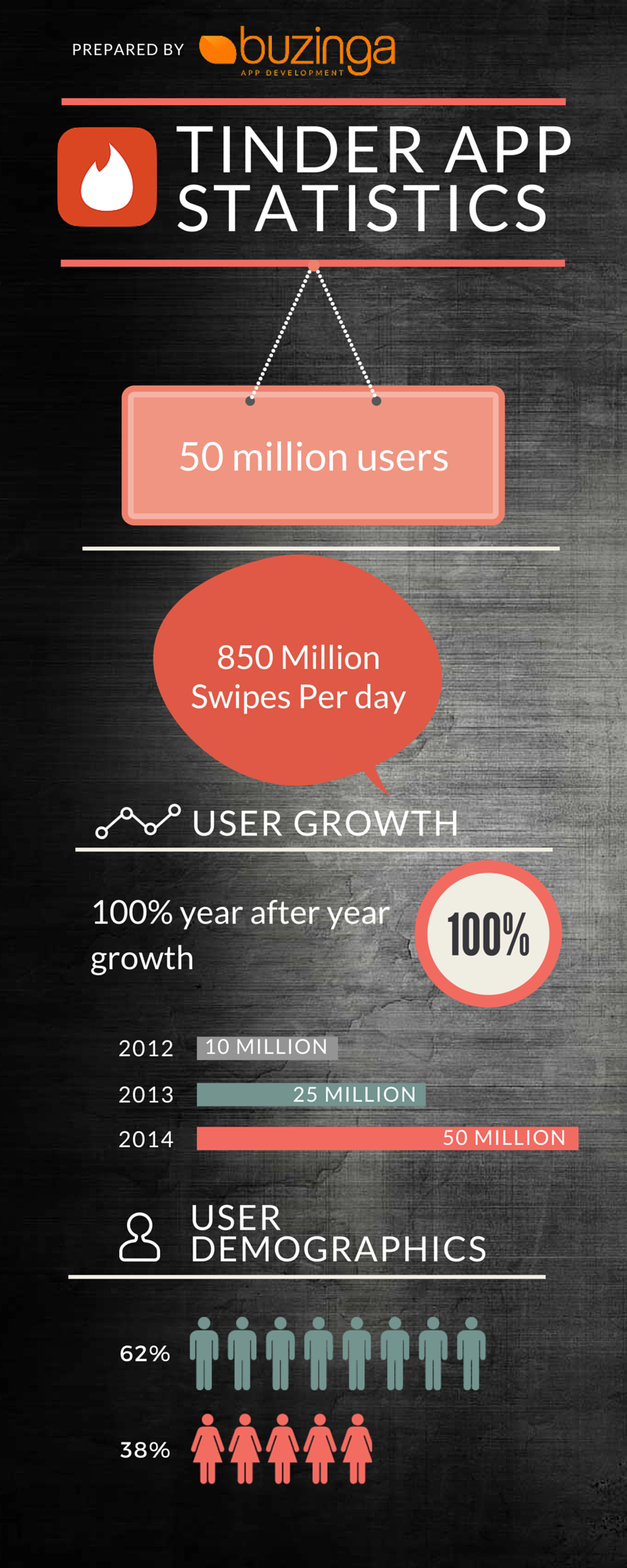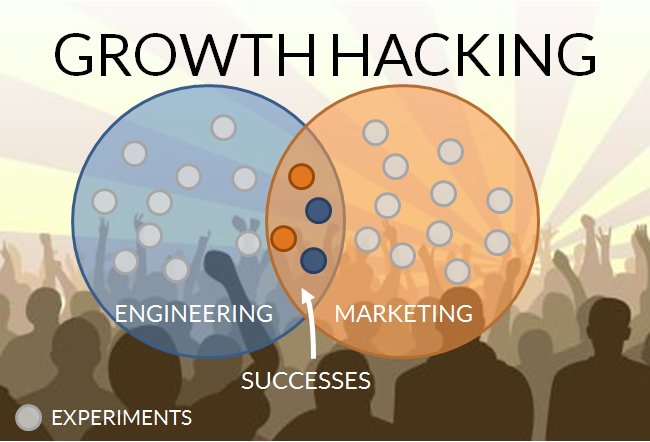App Growth Hack: How Tinder Turned Itself Into An Explosive Growth Machine
Unless you’ve banished yourself to solitary confinement in the Australia desert, I’m guessing you’ve heard of Tinder?
If you’re not a Tinder addict, I know you’ve secretly fantasised about what your bio and Tinderella/Fella would look like.
Don’t be shy… I know you have!
So why has Tinder experienced such explosive app growth?
Tinder’s growth over the past 3 years has been nothing short of phenomenal.
Founded in September, 2012, Tinder has seen 100% year over year growth.
To help you gather understanding of just how massive Tinder actually is, here’s an infographic:
(You can click to share this on Pinterest!)
The popular application has also acted as a pioneer for mobile user experience with its unique swiping concept.
What I want to focus on today is looking at how Tinder has achieved 100% year after year growth.
I want to dig a little deeper into the psychology and user experience tactics and explore how you can apply these principles to your own app.
And maybe you too can experience explosive app growth like Tinder.
Do you know how to build an app like Tinder?
Bonus: How To Build An App Born To Go Viral Like Candy Crush
So how do you build an app like Tinder?
Building Supply & Word Of Mouth
Source: 852CMD
With any marketplace, the key to building success is a term called ‘liquidity.’
What does this mean?
Let me give you a simple lesson in economics…
Simply, it’s the availability of buyers and sellers to participate in transactions.
In a market involving money, there must be an ample supply of buyers and enough sellers to participate.
Without both sides of the marketplace, there is no marketplace…
In app terms, you can’t have users without having an app first.
Why?
Because, this can be leveraged to your advantage by either paying for the supply or by offering incentives for participation.
If we look at Tinder, the sellers are women and the buyers are men.
Forgive me if this sounds a little sexist but this was an early growth hack tactic that Tinder used.
Bonus: Launch Hack: How To Get 100,000 Downloads In A Month
In any dating platform, the ‘supply’ of women on the platform is what triggers the participation of men.
Let’s think about this in everyday terms. It’s the same principle behind ladies day at the races or ‘ladies night’ promotions at your local nightclub.
If you plant the seeds of supply, your buyers will come to participate.
Tinder launched the app in a rather unconventional, yet intelligent way.
They targeted American college sorority girls to be Tinder’s early adopters.
As more girls joined the app, the guys living on campus wanted to know who was single.
Word of mouth caused the app to go viral across American colleges, with it’s ‘cheeky’ tantalising nature it’s main drawcard.
The Network Effect
With networks like Facebook, Linkedin and Tinder, it’s the size of the user base that’s critical to success.
This is perhaps even more important for an app like Tinder.
Why?
As Tinder is location based, the app is basically of no use without the sufficient quantity of potential matches.
Think about it… If you only had two matches on Tinder, would you bother to use it anymore?
The app needed to provide constant curiosity about who the next swipe was going to be.
This is where the college sorority network played an integral role in growth.
In conjunction with word of mouth, the technique ensured that there were always plenty of users in the area.
How can you use this to grow your app?
Once you’ve gained a sufficient user base through word of mouth, adoption will begin thanks to the network effect.
The more users you acquire in one geographical area, the more valuable your app becomes, leading to more downloads and engagement.
Why Do People Use Tinder?
Source: Pinterest
So far, I’ve spoken to you about Tinder’s early growth strategy but what is it about the app that users find so intriguing?
What keeps them using it, again and again and again and again and again… You get the picture.
Tinder, rather cleverly leveraged some core truths about user experience and psychology to make the app really, really addictive.
And Tinder is really addictive. [Not that I would know]
They created an app that’s worth talking about.
A mobile app on its own doesn’t create that much excitement.
You need to create an app that’s unique and will make people want to talk about it.
Bonus: How To Generate Buzz Before Launch
Let’s now take a look at at how Tinder has differentiated itself from other applications.
The User Experience
The major difference between Tinder and other apps is how you ‘navigate’ through your potential matches.
Matches are presented like you’re playing a game of cards.
If you like the card you keep it (Swipe right), if you dislike the card, you give it back to the dealer (Swipe left).
This user experience pattern is important for 2 reasons:
- The experience of reviewing your matches (swiping left or right) not only feels extremely satisfying but also extremely intuitive. The action feels natural on a smartphone. It’s easy to do with one hand making it perfect for moving quickly through a stack of potential matches.
- Presenting the match information on a card opens up more screen real estate for larger pictures. This real estate just isn’t possible in a list format or on a small screen with lots of options.
Gamification & Variable Rewards
 Source: Gravity 4
Source: Gravity 4
As it’s impossible to see who’s next, the urge to continually keep swiping is very powerful.
Deep down, we all know that we will probably never find our perfect match on Tinder.
But… What if that next card is your perfect match?
Variable Rewards are a very powerful psychological concept that is used in gambling.
And it works with Tinder perfectly.
It ensures users are continually swiping, hoping they’ll hit the Tinder ‘jackpot’ so to speak on the next swipe.
The thing heightening this reward even further is the thought that people have actually swiped right on you.
You don’t know who of course but its more than likely that at this very moment, someone thinks you’re attractive and has requested a match with you.
Make sure you check out our 3 part series on gamification in apps for more insights on this strategy!
Habit Building Psychology
According to Psychology Today, habit formation is the process where new behaviors become automatic.
As you saw about with variable reward, this links in perfectly with habit building.
The more a user swipes and returns to use the app, the more they continue to use the app.
Next thing, you’re checking Facebook, Instagram and… swiping through your potential matches on Tinder.
Tinder also appeals your deep seeded insecurities. Deep down, many people want to know that other people find them attractive or view them at ‘desirable.’
I’m sure you’ve felt that way at some point or other, even if you’re afraid to admit it.
When you match with someone, you get that instant little happy feeling of “Oh! She/He finds me attractive!”
For many users, a ‘hook-up’ isn’t the real reason for using Tinder. The act of ‘Tindering’ has actually become more significant then the potential date itself.
It’s very possible that Tinder may have designed a system that’s too powerful.
Most dating platforms promise ‘true love’ and then, an exit from the service.
Tinder’s value proposition is different.
It’s driven by who’s in your area right now and may be interested in you.
Even after you’ve been on a date with a successful match, the app’s gamified experience creates a strong urge for you to return.
It creates FOMO, a fear of missing out, combining this with variable rewards, this makes for a highly addictive app.
Bonus: 10 Addictive Strategies To Re-Engage Inactive App Users
How Can You Use These App Growth Hacks?
Tinder’s ‘grass roots’ marketing approach worked extremely well for them.
They immersed the app deep amongst their target market, essentially making them do all the heavy leg work.
Let’s just say for example that you’re developing a fitness app.
Wouldn’t it makes sense to introduce the app to people at your local gym?
As a geo-location based app, it’s very possible word will spread around your gym. Many people who go to gym live and breath fitness.
I’m sure you know at least one person like this.
They’ll have many friends who also like health and fitness.
The network works effect is well and truly, well… in effect… Your fitness app starts spreading to gyms all around Australia.
For this to work though, people must want to continually keep using your app, over and over again.
This is where psychology and user experience comes into the picture.
Your fitness app must build habit in your users, incentivising them with a ‘reward’ or stimulating their thinking in some manner.
Bonus: 6 Hot Tips For Designing A Magnificent User Experience
Your actions in your app most also feel like a ‘natural’ user experience.
Think about what actions are natural to your target user and implement them into your app.
Gain inspiration from similar apps as yours and capabilities on what they’re doing well.
At risk of sounding cliche, Tinder has a unique point of differentiation which sets it well apart from the other ‘dating’ apps.
Have you used Tinder? Has it become one of the regular social media channels that you check on a regular basis? Please let me know by commenting below.
Where To Go Next
How Uber, Angry Birds And Other Viral Apps Got Their First 10,000 Users
How Instagram Became The #1 Photo App In 8 Hours
Launch Hack: How To Get 100,000 Downloads In A Month
Latest posts by Logan Merrick (see all)
- Ep 18: Collective Campus’ CEO on Intrapreneurship and Corporate Innovation - December 20, 2016
- 50 User Engagement Strategies For Planning Memorable Mobile Experiences - December 19, 2016
- Latest Data: App Monetisation Trends And Drivers 2015-2020 - November 25, 2016










